A Comprehensive Report on Project Risk and Procurement Management
VerifiedAdded on 2020/06/06
|8
|2050
|57
Report
AI Summary
This report delves into the critical aspects of project risk and procurement management. It defines risk, its potential impact on organizations, and the importance of effective risk management strategies. The report explores the relationship between risk and procurement, emphasizing the need to minimize risks throughout the procurement process. It examines various tools and models used for project risk and procurement management, including analytical and formal methods, as well as complex models like the system dynamics model and delivery models. The value of theories, concepts, and models in project management is also discussed, highlighting their role in guiding practices and ensuring project success. The report concludes by emphasizing the importance of continuous evaluation and adaptation in managing project risks and optimizing procurement processes.
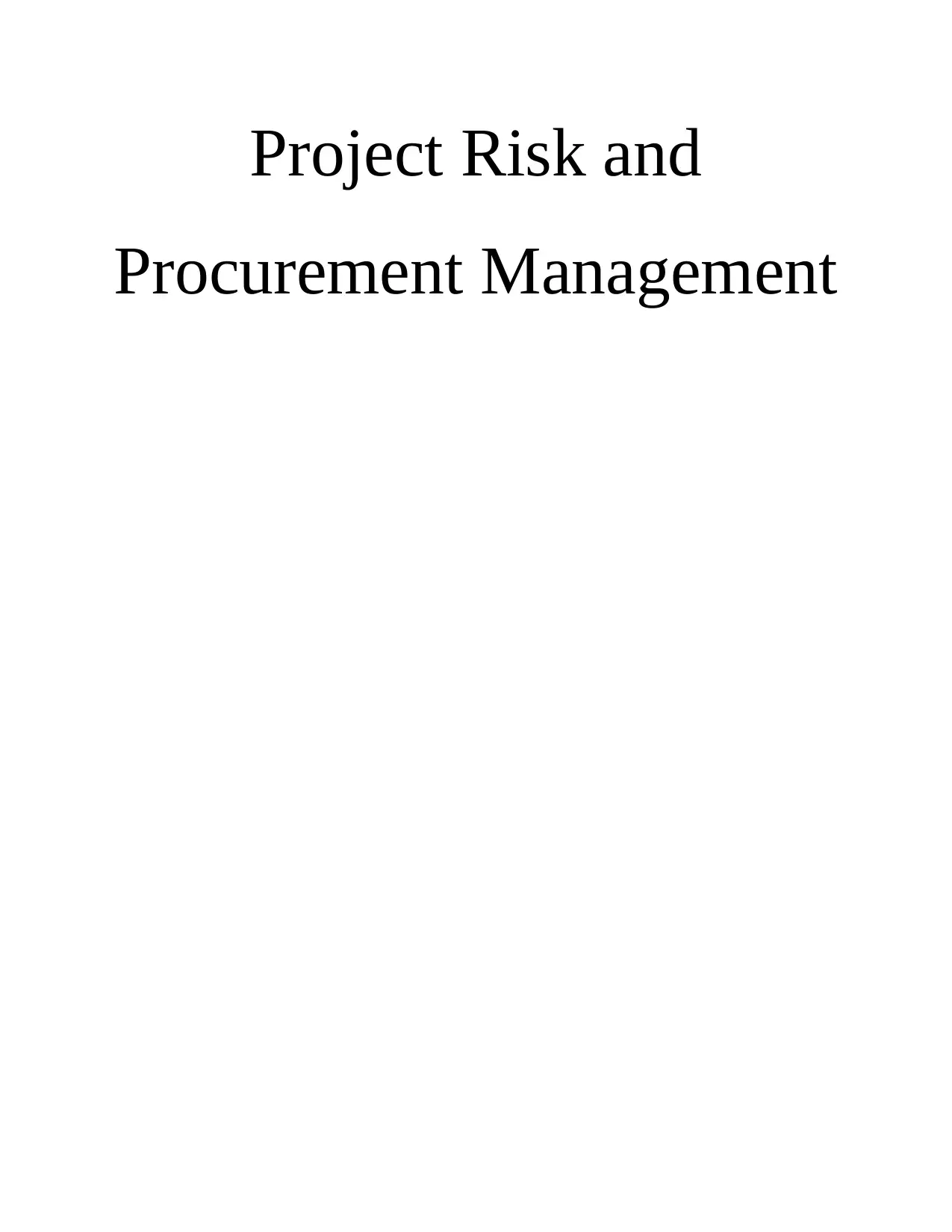
Project Risk and
Procurement Management
Procurement Management
Paraphrase This Document
Need a fresh take? Get an instant paraphrase of this document with our AI Paraphraser
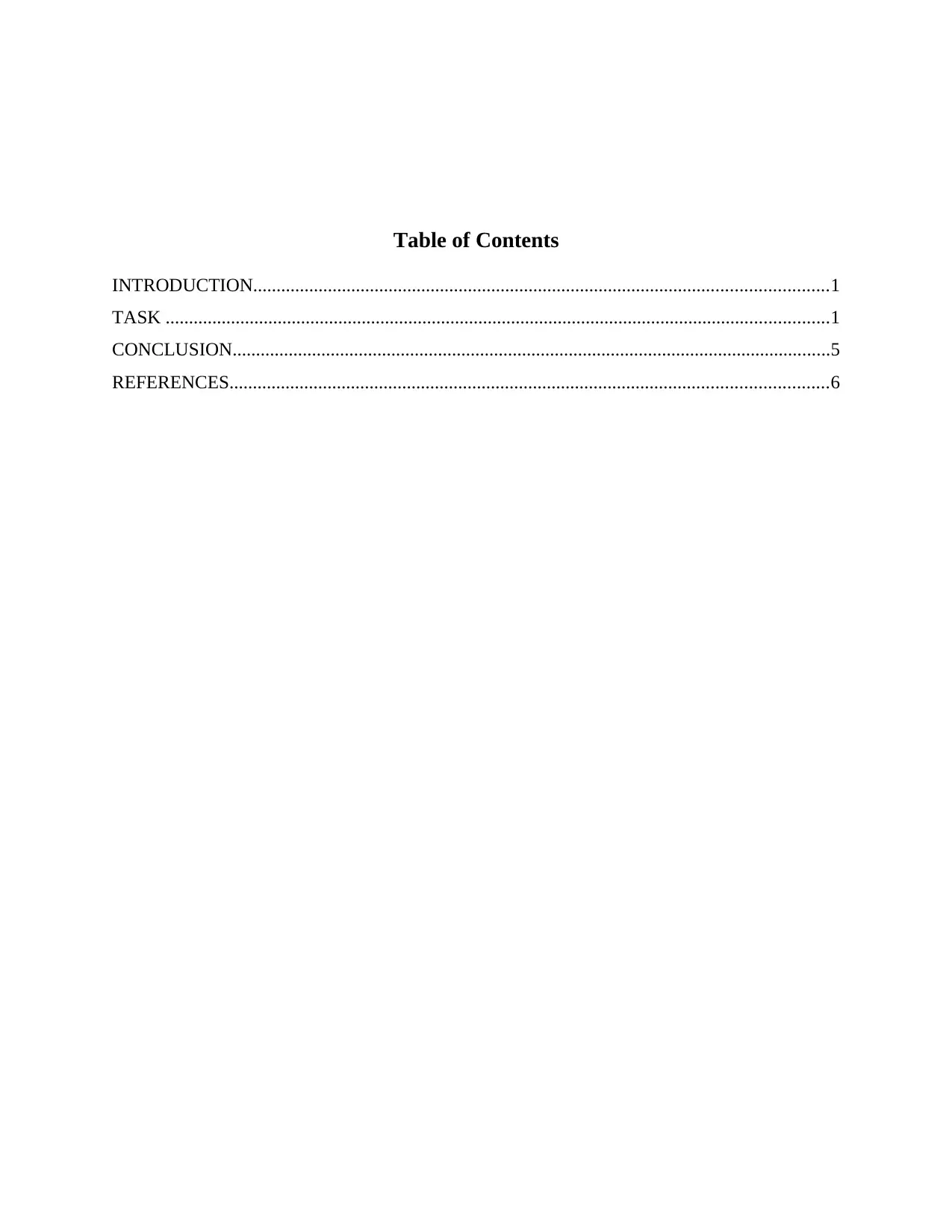
Table of Contents
INTRODUCTION...........................................................................................................................1
TASK ..............................................................................................................................................1
CONCLUSION................................................................................................................................5
REFERENCES................................................................................................................................6
INTRODUCTION...........................................................................................................................1
TASK ..............................................................................................................................................1
CONCLUSION................................................................................................................................5
REFERENCES................................................................................................................................6
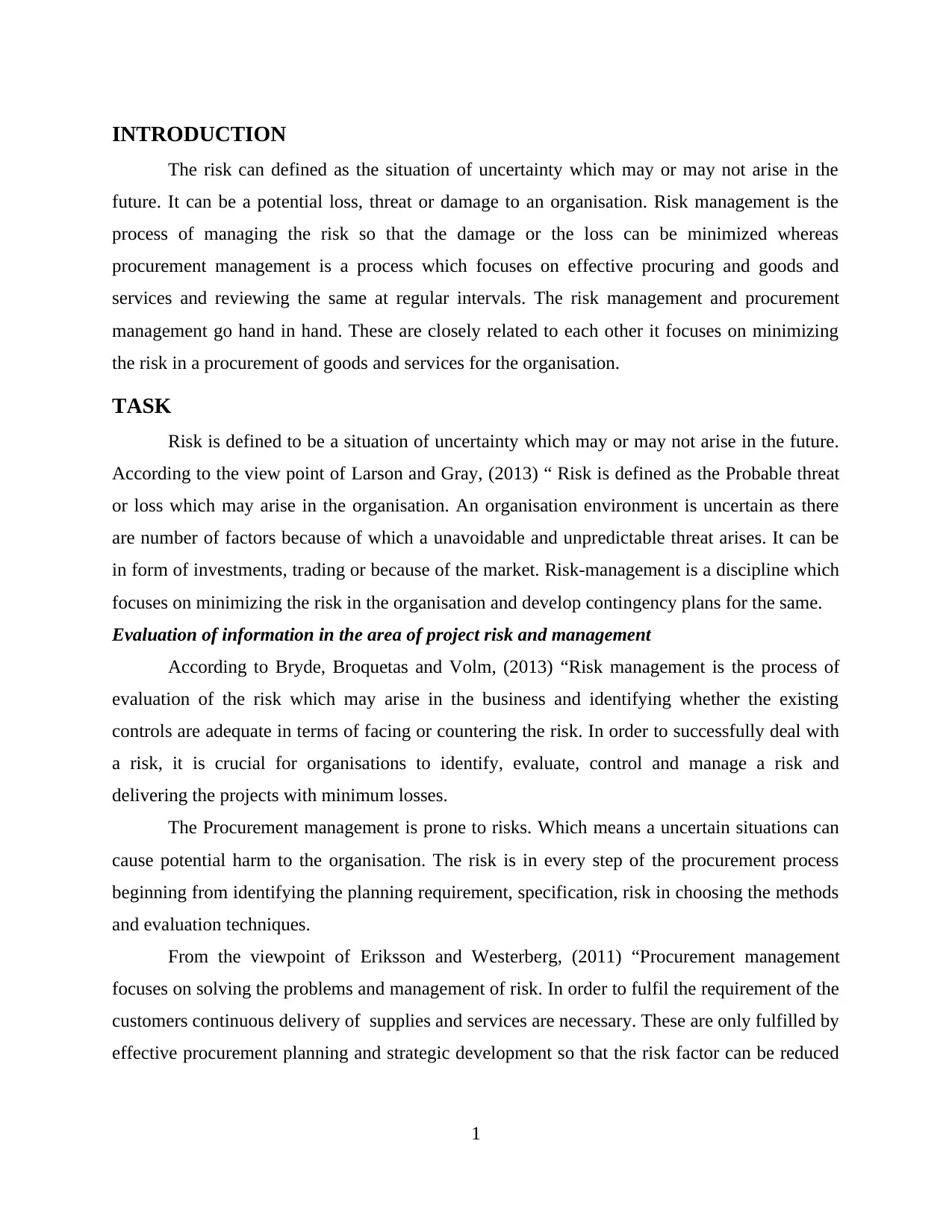
INTRODUCTION
The risk can defined as the situation of uncertainty which may or may not arise in the
future. It can be a potential loss, threat or damage to an organisation. Risk management is the
process of managing the risk so that the damage or the loss can be minimized whereas
procurement management is a process which focuses on effective procuring and goods and
services and reviewing the same at regular intervals. The risk management and procurement
management go hand in hand. These are closely related to each other it focuses on minimizing
the risk in a procurement of goods and services for the organisation.
TASK
Risk is defined to be a situation of uncertainty which may or may not arise in the future.
According to the view point of Larson and Gray, (2013) “ Risk is defined as the Probable threat
or loss which may arise in the organisation. An organisation environment is uncertain as there
are number of factors because of which a unavoidable and unpredictable threat arises. It can be
in form of investments, trading or because of the market. Risk-management is a discipline which
focuses on minimizing the risk in the organisation and develop contingency plans for the same.
Evaluation of information in the area of project risk and management
According to Bryde, Broquetas and Volm, (2013) “Risk management is the process of
evaluation of the risk which may arise in the business and identifying whether the existing
controls are adequate in terms of facing or countering the risk. In order to successfully deal with
a risk, it is crucial for organisations to identify, evaluate, control and manage a risk and
delivering the projects with minimum losses.
The Procurement management is prone to risks. Which means a uncertain situations can
cause potential harm to the organisation. The risk is in every step of the procurement process
beginning from identifying the planning requirement, specification, risk in choosing the methods
and evaluation techniques.
From the viewpoint of Eriksson and Westerberg, (2011) “Procurement management
focuses on solving the problems and management of risk. In order to fulfil the requirement of the
customers continuous delivery of supplies and services are necessary. These are only fulfilled by
effective procurement planning and strategic development so that the risk factor can be reduced
1
The risk can defined as the situation of uncertainty which may or may not arise in the
future. It can be a potential loss, threat or damage to an organisation. Risk management is the
process of managing the risk so that the damage or the loss can be minimized whereas
procurement management is a process which focuses on effective procuring and goods and
services and reviewing the same at regular intervals. The risk management and procurement
management go hand in hand. These are closely related to each other it focuses on minimizing
the risk in a procurement of goods and services for the organisation.
TASK
Risk is defined to be a situation of uncertainty which may or may not arise in the future.
According to the view point of Larson and Gray, (2013) “ Risk is defined as the Probable threat
or loss which may arise in the organisation. An organisation environment is uncertain as there
are number of factors because of which a unavoidable and unpredictable threat arises. It can be
in form of investments, trading or because of the market. Risk-management is a discipline which
focuses on minimizing the risk in the organisation and develop contingency plans for the same.
Evaluation of information in the area of project risk and management
According to Bryde, Broquetas and Volm, (2013) “Risk management is the process of
evaluation of the risk which may arise in the business and identifying whether the existing
controls are adequate in terms of facing or countering the risk. In order to successfully deal with
a risk, it is crucial for organisations to identify, evaluate, control and manage a risk and
delivering the projects with minimum losses.
The Procurement management is prone to risks. Which means a uncertain situations can
cause potential harm to the organisation. The risk is in every step of the procurement process
beginning from identifying the planning requirement, specification, risk in choosing the methods
and evaluation techniques.
From the viewpoint of Eriksson and Westerberg, (2011) “Procurement management
focuses on solving the problems and management of risk. In order to fulfil the requirement of the
customers continuous delivery of supplies and services are necessary. These are only fulfilled by
effective procurement planning and strategic development so that the risk factor can be reduced
1
⊘ This is a preview!⊘
Do you want full access?
Subscribe today to unlock all pages.

Trusted by 1+ million students worldwide
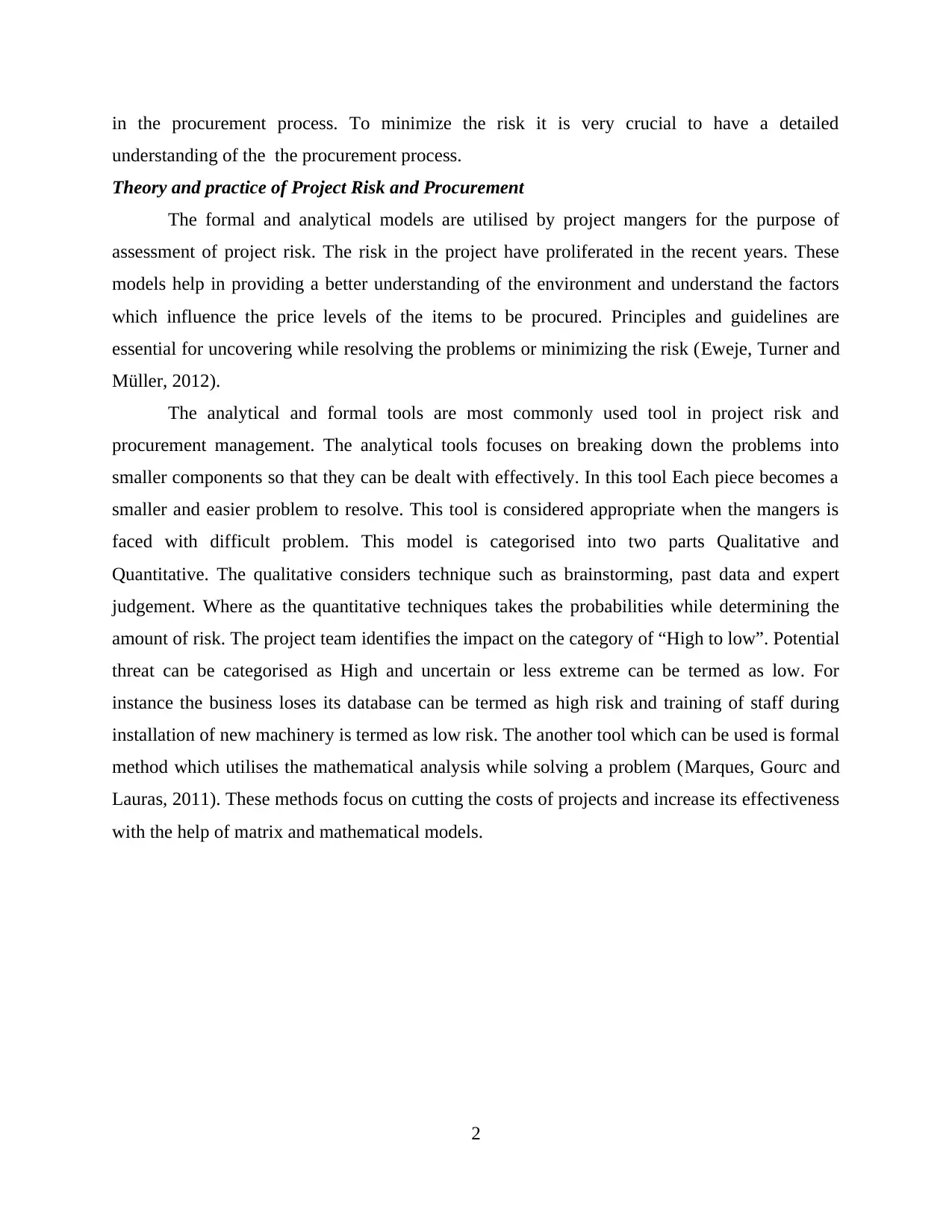
in the procurement process. To minimize the risk it is very crucial to have a detailed
understanding of the the procurement process.
Theory and practice of Project Risk and Procurement
The formal and analytical models are utilised by project mangers for the purpose of
assessment of project risk. The risk in the project have proliferated in the recent years. These
models help in providing a better understanding of the environment and understand the factors
which influence the price levels of the items to be procured. Principles and guidelines are
essential for uncovering while resolving the problems or minimizing the risk (Eweje, Turner and
Müller, 2012).
The analytical and formal tools are most commonly used tool in project risk and
procurement management. The analytical tools focuses on breaking down the problems into
smaller components so that they can be dealt with effectively. In this tool Each piece becomes a
smaller and easier problem to resolve. This tool is considered appropriate when the mangers is
faced with difficult problem. This model is categorised into two parts Qualitative and
Quantitative. The qualitative considers technique such as brainstorming, past data and expert
judgement. Where as the quantitative techniques takes the probabilities while determining the
amount of risk. The project team identifies the impact on the category of “High to low”. Potential
threat can be categorised as High and uncertain or less extreme can be termed as low. For
instance the business loses its database can be termed as high risk and training of staff during
installation of new machinery is termed as low risk. The another tool which can be used is formal
method which utilises the mathematical analysis while solving a problem (Marques, Gourc and
Lauras, 2011). These methods focus on cutting the costs of projects and increase its effectiveness
with the help of matrix and mathematical models.
2
understanding of the the procurement process.
Theory and practice of Project Risk and Procurement
The formal and analytical models are utilised by project mangers for the purpose of
assessment of project risk. The risk in the project have proliferated in the recent years. These
models help in providing a better understanding of the environment and understand the factors
which influence the price levels of the items to be procured. Principles and guidelines are
essential for uncovering while resolving the problems or minimizing the risk (Eweje, Turner and
Müller, 2012).
The analytical and formal tools are most commonly used tool in project risk and
procurement management. The analytical tools focuses on breaking down the problems into
smaller components so that they can be dealt with effectively. In this tool Each piece becomes a
smaller and easier problem to resolve. This tool is considered appropriate when the mangers is
faced with difficult problem. This model is categorised into two parts Qualitative and
Quantitative. The qualitative considers technique such as brainstorming, past data and expert
judgement. Where as the quantitative techniques takes the probabilities while determining the
amount of risk. The project team identifies the impact on the category of “High to low”. Potential
threat can be categorised as High and uncertain or less extreme can be termed as low. For
instance the business loses its database can be termed as high risk and training of staff during
installation of new machinery is termed as low risk. The another tool which can be used is formal
method which utilises the mathematical analysis while solving a problem (Marques, Gourc and
Lauras, 2011). These methods focus on cutting the costs of projects and increase its effectiveness
with the help of matrix and mathematical models.
2
Paraphrase This Document
Need a fresh take? Get an instant paraphrase of this document with our AI Paraphraser
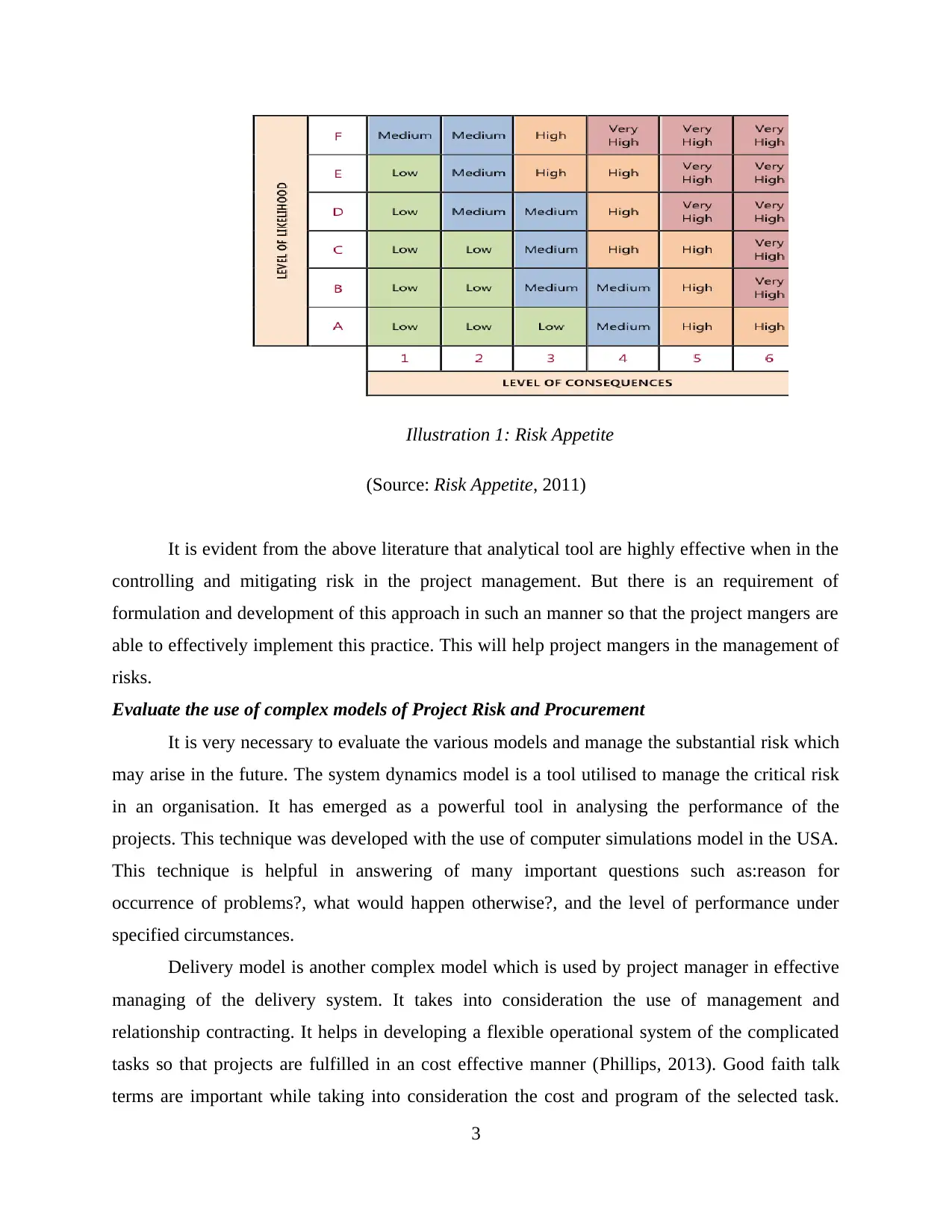
(Source: Risk Appetite, 2011)
It is evident from the above literature that analytical tool are highly effective when in the
controlling and mitigating risk in the project management. But there is an requirement of
formulation and development of this approach in such an manner so that the project mangers are
able to effectively implement this practice. This will help project mangers in the management of
risks.
Evaluate the use of complex models of Project Risk and Procurement
It is very necessary to evaluate the various models and manage the substantial risk which
may arise in the future. The system dynamics model is a tool utilised to manage the critical risk
in an organisation. It has emerged as a powerful tool in analysing the performance of the
projects. This technique was developed with the use of computer simulations model in the USA.
This technique is helpful in answering of many important questions such as:reason for
occurrence of problems?, what would happen otherwise?, and the level of performance under
specified circumstances.
Delivery model is another complex model which is used by project manager in effective
managing of the delivery system. It takes into consideration the use of management and
relationship contracting. It helps in developing a flexible operational system of the complicated
tasks so that projects are fulfilled in an cost effective manner (Phillips, 2013). Good faith talk
terms are important while taking into consideration the cost and program of the selected task.
3
Illustration 1: Risk Appetite
It is evident from the above literature that analytical tool are highly effective when in the
controlling and mitigating risk in the project management. But there is an requirement of
formulation and development of this approach in such an manner so that the project mangers are
able to effectively implement this practice. This will help project mangers in the management of
risks.
Evaluate the use of complex models of Project Risk and Procurement
It is very necessary to evaluate the various models and manage the substantial risk which
may arise in the future. The system dynamics model is a tool utilised to manage the critical risk
in an organisation. It has emerged as a powerful tool in analysing the performance of the
projects. This technique was developed with the use of computer simulations model in the USA.
This technique is helpful in answering of many important questions such as:reason for
occurrence of problems?, what would happen otherwise?, and the level of performance under
specified circumstances.
Delivery model is another complex model which is used by project manager in effective
managing of the delivery system. It takes into consideration the use of management and
relationship contracting. It helps in developing a flexible operational system of the complicated
tasks so that projects are fulfilled in an cost effective manner (Phillips, 2013). Good faith talk
terms are important while taking into consideration the cost and program of the selected task.
3
Illustration 1: Risk Appetite
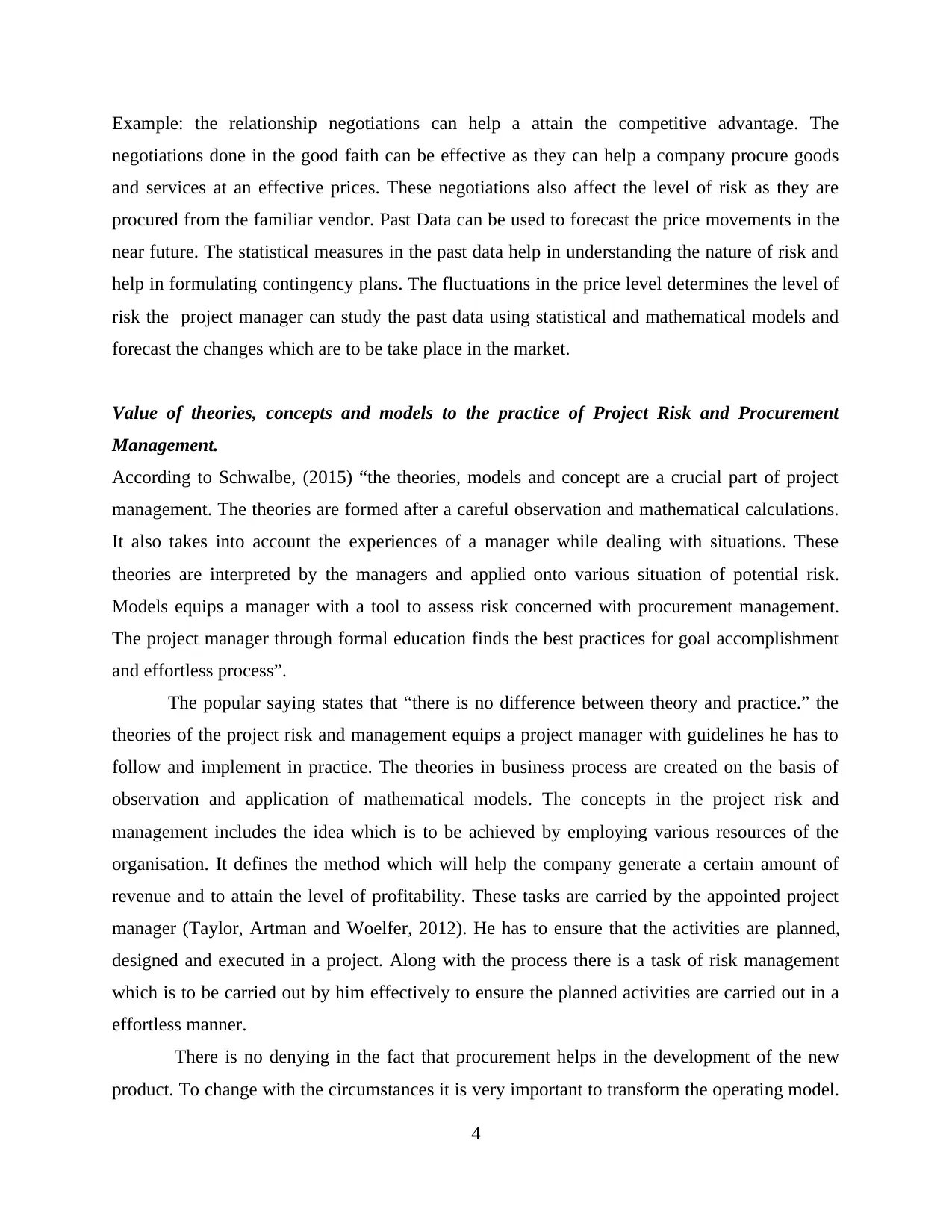
Example: the relationship negotiations can help a attain the competitive advantage. The
negotiations done in the good faith can be effective as they can help a company procure goods
and services at an effective prices. These negotiations also affect the level of risk as they are
procured from the familiar vendor. Past Data can be used to forecast the price movements in the
near future. The statistical measures in the past data help in understanding the nature of risk and
help in formulating contingency plans. The fluctuations in the price level determines the level of
risk the project manager can study the past data using statistical and mathematical models and
forecast the changes which are to be take place in the market.
Value of theories, concepts and models to the practice of Project Risk and Procurement
Management.
According to Schwalbe, (2015) “the theories, models and concept are a crucial part of project
management. The theories are formed after a careful observation and mathematical calculations.
It also takes into account the experiences of a manager while dealing with situations. These
theories are interpreted by the managers and applied onto various situation of potential risk.
Models equips a manager with a tool to assess risk concerned with procurement management.
The project manager through formal education finds the best practices for goal accomplishment
and effortless process”.
The popular saying states that “there is no difference between theory and practice.” the
theories of the project risk and management equips a project manager with guidelines he has to
follow and implement in practice. The theories in business process are created on the basis of
observation and application of mathematical models. The concepts in the project risk and
management includes the idea which is to be achieved by employing various resources of the
organisation. It defines the method which will help the company generate a certain amount of
revenue and to attain the level of profitability. These tasks are carried by the appointed project
manager (Taylor, Artman and Woelfer, 2012). He has to ensure that the activities are planned,
designed and executed in a project. Along with the process there is a task of risk management
which is to be carried out by him effectively to ensure the planned activities are carried out in a
effortless manner.
There is no denying in the fact that procurement helps in the development of the new
product. To change with the circumstances it is very important to transform the operating model.
4
negotiations done in the good faith can be effective as they can help a company procure goods
and services at an effective prices. These negotiations also affect the level of risk as they are
procured from the familiar vendor. Past Data can be used to forecast the price movements in the
near future. The statistical measures in the past data help in understanding the nature of risk and
help in formulating contingency plans. The fluctuations in the price level determines the level of
risk the project manager can study the past data using statistical and mathematical models and
forecast the changes which are to be take place in the market.
Value of theories, concepts and models to the practice of Project Risk and Procurement
Management.
According to Schwalbe, (2015) “the theories, models and concept are a crucial part of project
management. The theories are formed after a careful observation and mathematical calculations.
It also takes into account the experiences of a manager while dealing with situations. These
theories are interpreted by the managers and applied onto various situation of potential risk.
Models equips a manager with a tool to assess risk concerned with procurement management.
The project manager through formal education finds the best practices for goal accomplishment
and effortless process”.
The popular saying states that “there is no difference between theory and practice.” the
theories of the project risk and management equips a project manager with guidelines he has to
follow and implement in practice. The theories in business process are created on the basis of
observation and application of mathematical models. The concepts in the project risk and
management includes the idea which is to be achieved by employing various resources of the
organisation. It defines the method which will help the company generate a certain amount of
revenue and to attain the level of profitability. These tasks are carried by the appointed project
manager (Taylor, Artman and Woelfer, 2012). He has to ensure that the activities are planned,
designed and executed in a project. Along with the process there is a task of risk management
which is to be carried out by him effectively to ensure the planned activities are carried out in a
effortless manner.
There is no denying in the fact that procurement helps in the development of the new
product. To change with the circumstances it is very important to transform the operating model.
4
⊘ This is a preview!⊘
Do you want full access?
Subscribe today to unlock all pages.

Trusted by 1+ million students worldwide
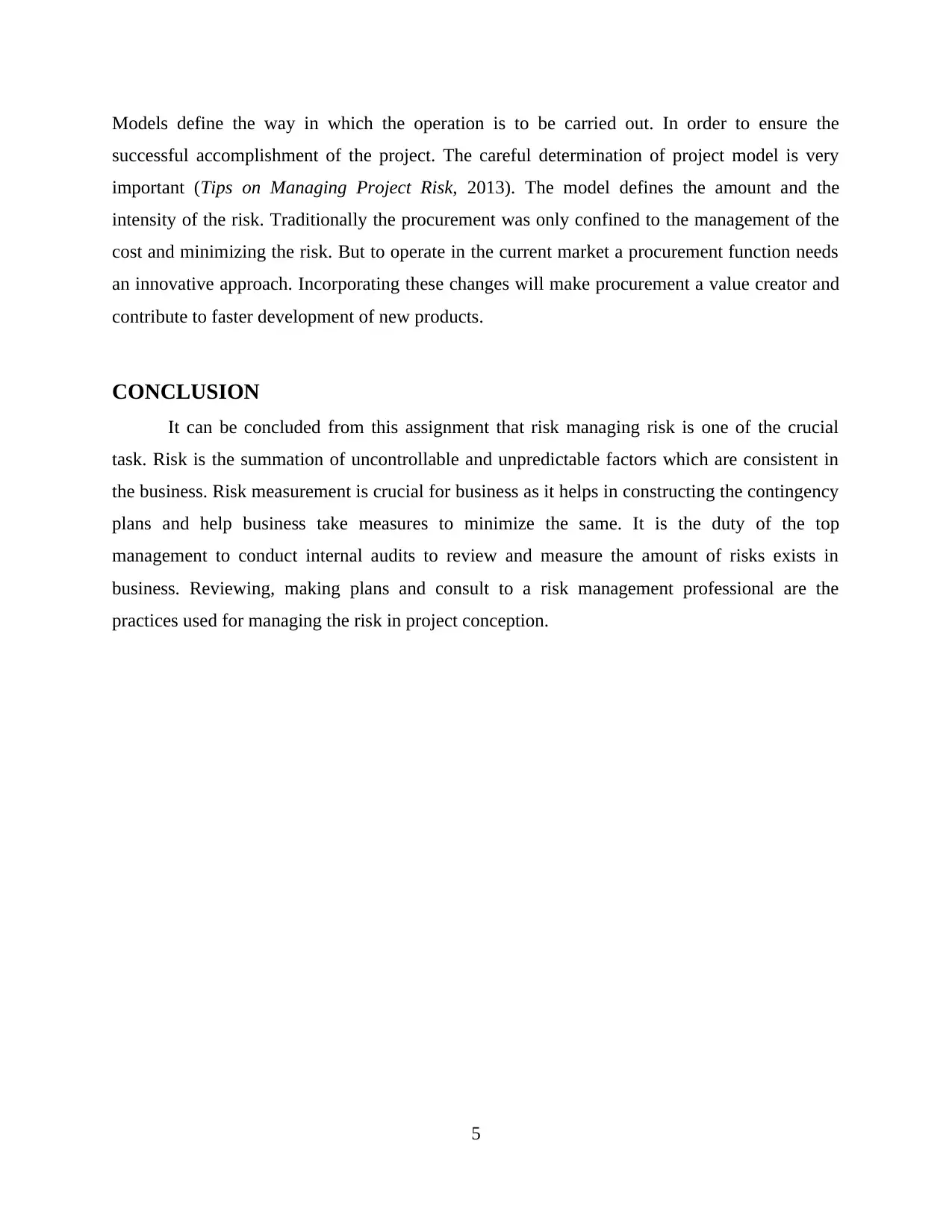
Models define the way in which the operation is to be carried out. In order to ensure the
successful accomplishment of the project. The careful determination of project model is very
important (Tips on Managing Project Risk, 2013). The model defines the amount and the
intensity of the risk. Traditionally the procurement was only confined to the management of the
cost and minimizing the risk. But to operate in the current market a procurement function needs
an innovative approach. Incorporating these changes will make procurement a value creator and
contribute to faster development of new products.
CONCLUSION
It can be concluded from this assignment that risk managing risk is one of the crucial
task. Risk is the summation of uncontrollable and unpredictable factors which are consistent in
the business. Risk measurement is crucial for business as it helps in constructing the contingency
plans and help business take measures to minimize the same. It is the duty of the top
management to conduct internal audits to review and measure the amount of risks exists in
business. Reviewing, making plans and consult to a risk management professional are the
practices used for managing the risk in project conception.
5
successful accomplishment of the project. The careful determination of project model is very
important (Tips on Managing Project Risk, 2013). The model defines the amount and the
intensity of the risk. Traditionally the procurement was only confined to the management of the
cost and minimizing the risk. But to operate in the current market a procurement function needs
an innovative approach. Incorporating these changes will make procurement a value creator and
contribute to faster development of new products.
CONCLUSION
It can be concluded from this assignment that risk managing risk is one of the crucial
task. Risk is the summation of uncontrollable and unpredictable factors which are consistent in
the business. Risk measurement is crucial for business as it helps in constructing the contingency
plans and help business take measures to minimize the same. It is the duty of the top
management to conduct internal audits to review and measure the amount of risks exists in
business. Reviewing, making plans and consult to a risk management professional are the
practices used for managing the risk in project conception.
5
Paraphrase This Document
Need a fresh take? Get an instant paraphrase of this document with our AI Paraphraser
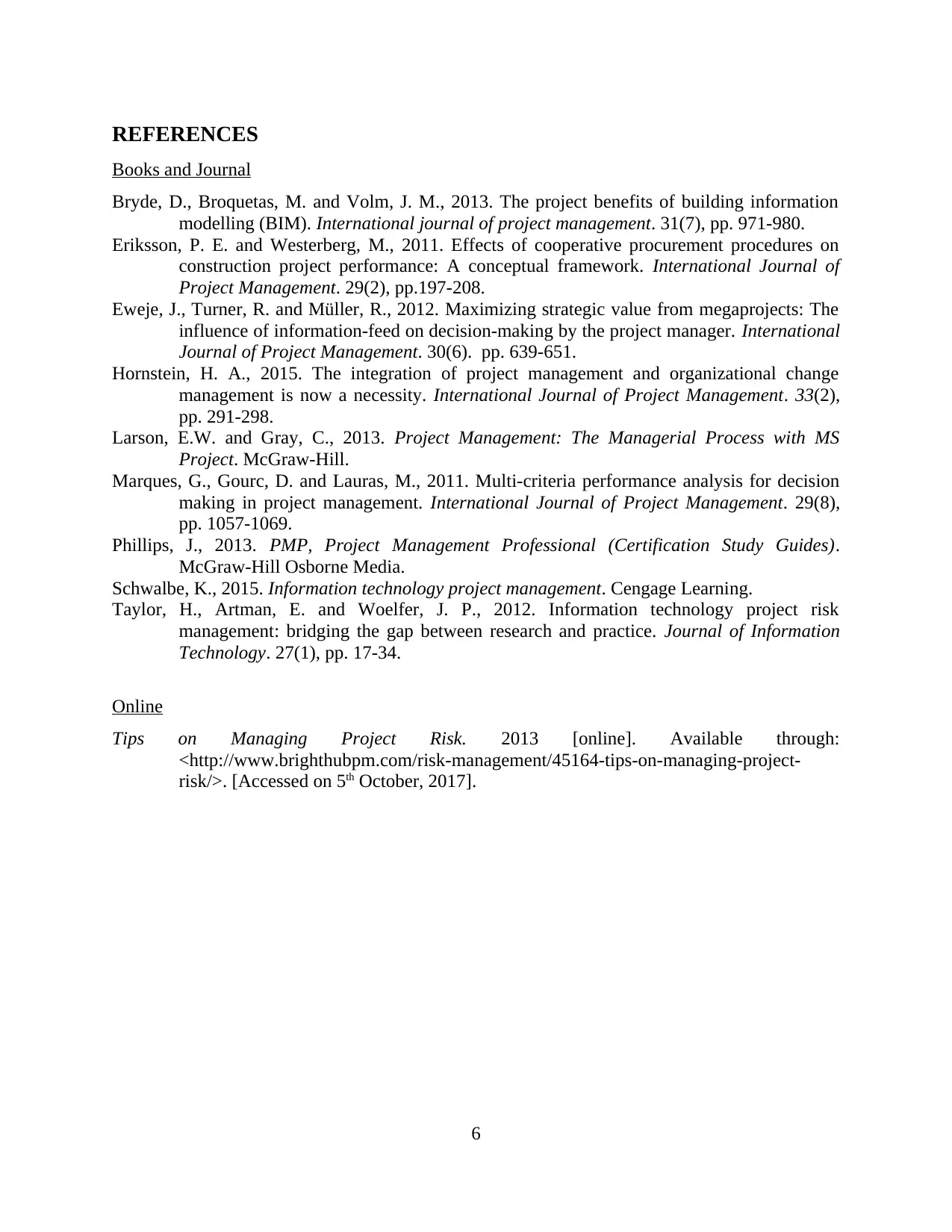
REFERENCES
Books and Journal
Bryde, D., Broquetas, M. and Volm, J. M., 2013. The project benefits of building information
modelling (BIM). International journal of project management. 31(7), pp. 971-980.
Eriksson, P. E. and Westerberg, M., 2011. Effects of cooperative procurement procedures on
construction project performance: A conceptual framework. International Journal of
Project Management. 29(2), pp.197-208.
Eweje, J., Turner, R. and Müller, R., 2012. Maximizing strategic value from megaprojects: The
influence of information-feed on decision-making by the project manager. International
Journal of Project Management. 30(6). pp. 639-651.
Hornstein, H. A., 2015. The integration of project management and organizational change
management is now a necessity. International Journal of Project Management. 33(2),
pp. 291-298.
Larson, E.W. and Gray, C., 2013. Project Management: The Managerial Process with MS
Project. McGraw-Hill.
Marques, G., Gourc, D. and Lauras, M., 2011. Multi-criteria performance analysis for decision
making in project management. International Journal of Project Management. 29(8),
pp. 1057-1069.
Phillips, J., 2013. PMP, Project Management Professional (Certification Study Guides).
McGraw-Hill Osborne Media.
Schwalbe, K., 2015. Information technology project management. Cengage Learning.
Taylor, H., Artman, E. and Woelfer, J. P., 2012. Information technology project risk
management: bridging the gap between research and practice. Journal of Information
Technology. 27(1), pp. 17-34.
Online
Tips on Managing Project Risk. 2013 [online]. Available through:
<http://www.brighthubpm.com/risk-management/45164-tips-on-managing-project-
risk/>. [Accessed on 5th October, 2017].
6
Books and Journal
Bryde, D., Broquetas, M. and Volm, J. M., 2013. The project benefits of building information
modelling (BIM). International journal of project management. 31(7), pp. 971-980.
Eriksson, P. E. and Westerberg, M., 2011. Effects of cooperative procurement procedures on
construction project performance: A conceptual framework. International Journal of
Project Management. 29(2), pp.197-208.
Eweje, J., Turner, R. and Müller, R., 2012. Maximizing strategic value from megaprojects: The
influence of information-feed on decision-making by the project manager. International
Journal of Project Management. 30(6). pp. 639-651.
Hornstein, H. A., 2015. The integration of project management and organizational change
management is now a necessity. International Journal of Project Management. 33(2),
pp. 291-298.
Larson, E.W. and Gray, C., 2013. Project Management: The Managerial Process with MS
Project. McGraw-Hill.
Marques, G., Gourc, D. and Lauras, M., 2011. Multi-criteria performance analysis for decision
making in project management. International Journal of Project Management. 29(8),
pp. 1057-1069.
Phillips, J., 2013. PMP, Project Management Professional (Certification Study Guides).
McGraw-Hill Osborne Media.
Schwalbe, K., 2015. Information technology project management. Cengage Learning.
Taylor, H., Artman, E. and Woelfer, J. P., 2012. Information technology project risk
management: bridging the gap between research and practice. Journal of Information
Technology. 27(1), pp. 17-34.
Online
Tips on Managing Project Risk. 2013 [online]. Available through:
<http://www.brighthubpm.com/risk-management/45164-tips-on-managing-project-
risk/>. [Accessed on 5th October, 2017].
6
1 out of 8
Related Documents
Your All-in-One AI-Powered Toolkit for Academic Success.
+13062052269
info@desklib.com
Available 24*7 on WhatsApp / Email
![[object Object]](/_next/static/media/star-bottom.7253800d.svg)
Unlock your academic potential
Copyright © 2020–2025 A2Z Services. All Rights Reserved. Developed and managed by ZUCOL.




